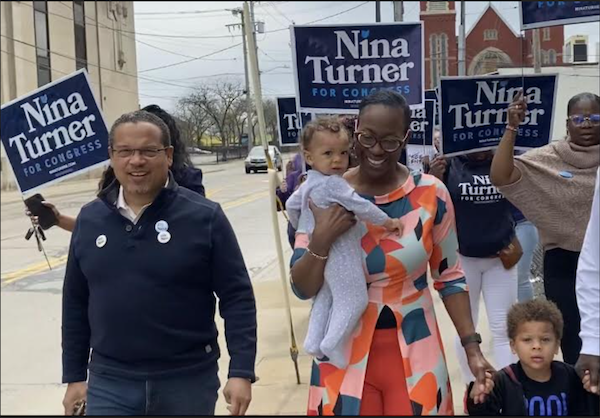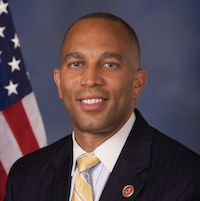Revamped district but same passion, from self-described “fighter”

Minnesota Attorney General and former Congressman Keith Ellison campaigns with Nina Turner and her grandchildren in Cleveland, April 30, 2022. Photo Credit/Angelo Greco
Like the Energizer Bunny, Nina Turner keeps on coming and coming and coming.
The characterization is not meant to disparage, but rather to reflect the tirelessness with which the former state senator relentlessly repeats her displeasure with a status quo that in her view, stacks the deck against the poor, the working poor, and the barely middle class, even as the hegemon that is the United States protects and further empowers the greedy capitalists who tilt government policies in their favor.
Turner is seeking the Democratic nomination to represent the reshaped 11th Congressional District in this week’s May 3 primary. We interviewed her by phone early Saturday morning as she began to tour the district with Minnesota Attorney General Keith Ellison.
Rematch
The contest is a rematch from last August, when Turner came in second to then-county councilwoman Shontel Brown in the special election to succeed former Congresswoman Marcia Fudge, who resigned a year ago to join the Biden administration as Secretary of Housing. Brown went on to win the general election in November and has been serving in Congress since late last year.
While this month’s primary is widely seen as a rematch between the establishment wing of the party, epitomized by Brown, and the progressive wing represented by Turner, there are some significant differences in this follow up contest. For starters, Brown is running as the incumbent, with the inherent advantages that status confers.
Of perhaps equal import, the district has been substantially redrawn and no longer includes Summit County, which the candidates essentially split. Key additions to the district include the entire west side of Cleveland and the suburb of Lakewood, a sizable bloc of politically active voters.
Also, while there were 13 names on the August special election ballot, this time around there are only two. The eleven also-rans garnered just over five percent of the vote; if those had gone to Turner, that special election would have been a virtual dead heat.
One other difference from last year’s campaign, which may prove the wild card in the rematch: the mood of the electorate. Partisan skullduggery, exemplified by GOP manipulation of the redistricting process, has resulted in the need for two primaries, voting in Congressional districts that may or may not be temporary, and immense confusion on the part of many citizens unaware there is a primary in two days or that they may be in a new district.
The campaign that better manages these dynamics will likely be Tuesday’s winner and the District 11 representative in the next Congress come January, after the November election that will heavily favor the primary victor.
Turner said the number one lesson she drew from last year’s defeat was that her campaign did not do enough field work to reach voters. To rectify that mistake, she said she is running a “field first” campaign. “We started door to door in early February”, she said, knocking on a thousand doors every day at first, and ramping that up to 2000 daily.
She says her campaign has touched 100,000 voters through a combination of door-knocking, phone calling and text messaging. To achieve this, the campaign has used a field staff of 20 full- and part-time workers who are being paid $15/hour. The wage is a reflection, she says, of her commitment to seeing that people earn a living wage for whatever work they do.
Turner has drawn two conclusions from her interactions with voters this cycle. One is that they are stressed out, a result of both the toll taken by the economy and the ongoing pandemic that has been exacerbated by confusion produced by Republican efforts to game the system. While noting that these conditions apply nationally as a part of the GOP’s strategy, she focused her ire on Ohio Republicans who she said, already have a super-majority in the legislature, but still want to game the system. She said that her party should have seen this coming and been better prepared to deal with it.
A second key impression Turner says she is gathering from voters is that, even more than last year, they want a fighter, someone they know will go to bat for them. “Working people are being pushed back,” she says, losing ground economically to the point where their children’s expectations are dimmer than those of past generations.
Platform
A former history professor at Cuyahoga Community College, Turner argues that her core platform for working people — a $15 minimum wage, Medicare for All, and protection of the right to vote — are traditional Democratic values from an era when her party identified as the party of the people. She sees a platform continuum that extends from the presidency of Franklin D. Roosevelt through A. Philip Randolph to Martin Luther King, all of whom were derided by their opponents as “socialists” for their commitment to the poor and the working classes.
Turner said that we are “at a moment in this district and the nation” where voters want “somebody that will put our needs above the corporate interests that dominate our politics.”
She cites her record in fighting to overturn Senate Bill 5 [which restricted collective bargaining], support the Cleveland School Plan, and reorganize county government, as validating her willingness to go all out on behalf of her constituency to protect their interests and improve their lives.
It’s not enough to do the minimum and then sit back and say someone else should step up, she said, a pointed reference to her opponent’s stance on voting rights.
“I don’t poll test, talk to consultants or status quo politicians” to figure out what to do, Turner asserts. Voters will know that as their Congresswoman, “my only special interest will be changing the material conditions of those who live, work and play in this district.”
• • •• • •

















